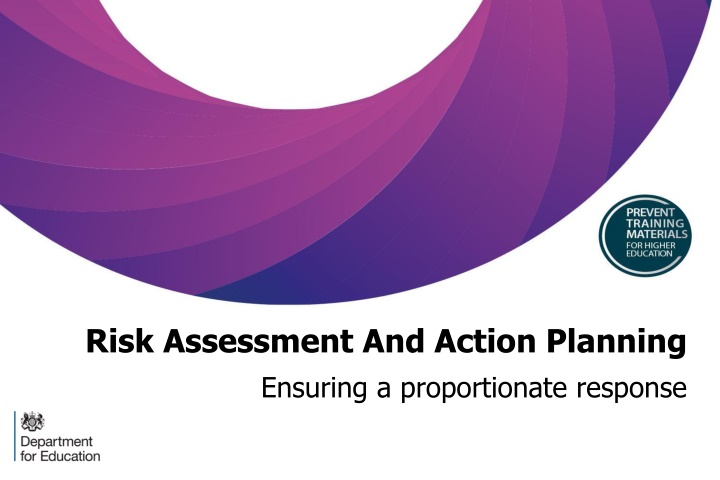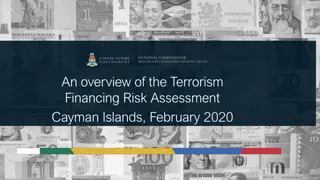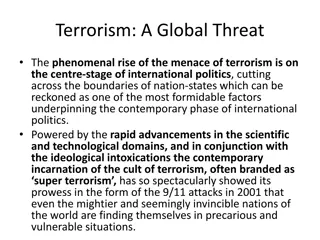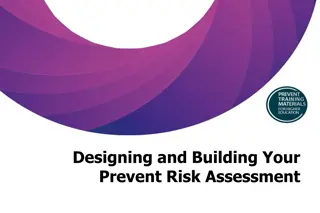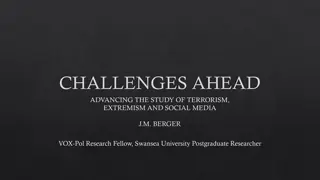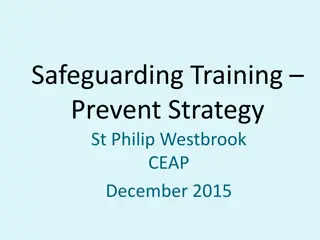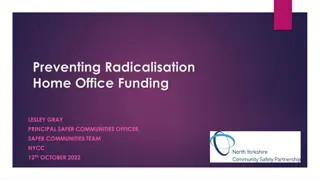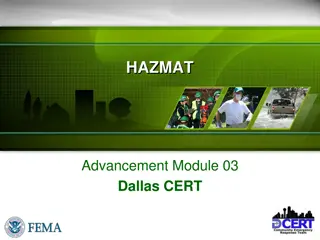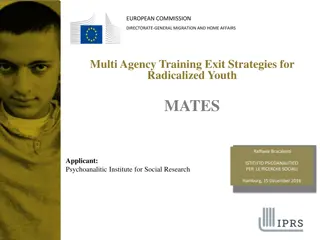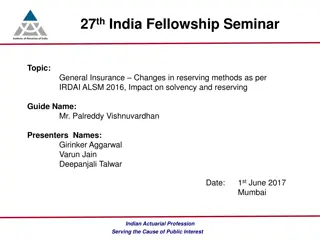Effective Strategies for Preventing Terrorism: Risk Assessment and Action Planning
Counter-Terrorism and Security Act 2015 mandates Higher Education providers to conduct risk assessments to prevent students from being drawn into terrorism. Understanding the law and compliance requirements is crucial, followed by developing a thorough action plan driven by risk analysis. The plan should include clear responsibilities, timescales, and be updated regularly to ensure effective prevention measures.
Download Presentation

Please find below an Image/Link to download the presentation.
The content on the website is provided AS IS for your information and personal use only. It may not be sold, licensed, or shared on other websites without obtaining consent from the author.If you encounter any issues during the download, it is possible that the publisher has removed the file from their server.
You are allowed to download the files provided on this website for personal or commercial use, subject to the condition that they are used lawfully. All files are the property of their respective owners.
The content on the website is provided AS IS for your information and personal use only. It may not be sold, licensed, or shared on other websites without obtaining consent from the author.
E N D
Presentation Transcript
Risk Assessment And Action Planning Ensuring a proportionate response
Whats required? Counter Terrorism and Security (CT&S) Act 2015 states that RHEBs will be expected to: carry out a risk assessment for their institution which assesses where and how their students might be at risk of being drawn into terrorism As stated in the Prevent duty guidance for Higher Education providers in England and Wales
Understanding the law The Counter-Terrorism Secuiry Act (CTSA) and guidance place clear obligations on institutions. It s important to understand the meaning of due regard and the risks [Section 26 CTSA 2015].
Understanding the compliance requirements Check the in-place structures and policies. Brief and plan early anticipate: Planning must determine what is most important to mitigate in accordance with the overall organisational need and the Prevent duty. Ensure that the required organisational capability to anticipate and manage risks is in place at all levels and in the appropriate departments Ensure clarity on regulator submission requirements and timescales.
A thorough and dynamic action plan Your action plan will be driven by the risk analysis (it s fine to have a combined analysis and plan). A whole organisation approach is likely to be most effective: avoid internal competition managers and their departments and functions should be clear on cross-department workstreams and ensure cooperation buy-in achieved through ownership and understanding Organisational divisions may hinder progress towards Prevent compliance. Consider inclusion of other aspects of the CONTEST Strategy in the risk assessment and action plan implementation.
What to include in the action plan Include responsibilities and timescales, which should reflect the severity of individual risks as identified in the risk assessment part of the process Updated at a specified and agreed rate throughout the year, linked to internal and/or external drivers Responsive to changes Centrally coordinated, with ownership and responsibilities spelled out and agreed
Getting the balance right (1/2) Risk assessment: Related to the overall probability of occurrence, impact and mitigation measures required to manage the threat of radicalisation and extremism Action plan: Management and operational process to mitigate any perceived risk Proportionate response Aligned with organisational culture, context, priorities and the risk itself Example of balance with human rights and free speech
Getting the balance right (2/2) Ensure balance by developing plans that are based on a clear understanding: of risks involved and of the processes that need to be considered to manage them. that the action plan and associated risk assessment that you are required to produce will provide a risk-aligned and updatable point of reference, guidance and direction. Action plans should consider and take into account both internal and external drivers such as: business processes, method of delivery, semesters and events. Counter-Terrorism threat information, OfS submission deadlines.
Capture everything you can Capture potential risks and issues in your risk assessment and action plan. Time on this, is time well spent. Expend as much effort as required on your risk assessment and action plan. If you fail to identify all of the risks or fail to indicate the actions that are required in adequate detail, your risk assessment and action plan will be of little worth or use. Consult widely internally and externally. Not all organisations have the same structure and resource and plans should reflect this. For example chaplaincy?
Things change... Risks will change and develop over time and the assessment, management and action plans that you put in place will require constant and regular review and updating. Examples of change drivers: A change in the general terrorism threat level and international, national, regional or local incidences of radicalisation and extremist/terrorist incidents and events Political and other directives that may have an impact and shift views on the legitimacy or otherwise of what may be considered risks of people being drawn into terrorism including changes to the threshold of intervention Change to your own organisational profile, capability or alignment to particular ideas or ideologies. Workforce and student cohort changes for example demographic or teaching delivery. This may depend upon your location, operating environment or even the type of course or programme that you deliver
Risk assessment drivers The HE Guidance usefully outlines some areas that may be considered relevant areas of potential risk: effective Partnership external speakers and events IT including the viewing, production and dissemination of terrorism-related material staff training welfare, pastoral support and chaplaincy services
Risk - effective partnerships The expectation of active engagement from senior management of the university (including, where appropriate, Vice Chancellors and governing bodies) Department for Education Regional Prevent Coordinators Local Authority Prevent Coordinators who manage Prevent Boards and support the Channel support scheme Local Police Prevent teams Cross-organisation involvement often includes estates/security, student services, communications and media, students and Students Union See Paragraphs 16 18 HE guidance.
Risk - external speakers and events Requirement to have a system in place to identify, assess and manage events Includes online and off campus branded and affiliated events Policy and process must take account of all freedom of speech and other related law and requirements balance Regional Prevent Coordinators support See paragraphs 7 15 HE guidance.
Risk - IT (including the viewing, retention and dissemination of terrorism related material) RHEBs are expected to have policies in place to manage the use of their IT equipment and online access. Consider the use of filtering to restrict access to harmful online material. Clear policies and procedures for students and staff working on sensitive or extremism-related research and this should be considered and authorised, usually by ethics committees or similar. See paragraphs 27 28 HE guidance.
Risk - staff training Appropriate staff identified to undertake Prevent awareness training The training should: provide staff with an understanding of the factors that make people support terrorist ideologies or engage in terrorist-related activity enable them to recognise vulnerability to being drawn into terrorism be aware of what action to take in response RHEB must have clear pathways for consideration and referral of cases for internal or external support See paragraphs 22 24 HE guidance
Risk - welfare, pastoral support and chaplaincy services Expectation of adequate and effective welfare and pastoral support for students of all backgrounds Where prayer and other faith related facilities are available organisations must have effective policies and practices to ensure effective oversight of their use Processes in place to manage issues that might arise from the use of such facilities The Prevent Duty does not create a mandate for the provision of facilities for any faith where they did not exist or are not required See paragraphs 25 26 HE guidance.
Consequential risk Consequential risks are those which affect either us or others around us as a result of the initial risk having a further impact or because we have failed to mitigate that initial risk effectively. Caused by our own process failures, the change in the risk itself, or by the actions and events that we are attempting to manage. Move away from the concept of risk management in the context of Prevent as a simple, one- dimensional or once only activity. Risk management should be a cyclical process subject to constant reassessment and re-evaluation. Prevent risk management involves a significant degree of thought, anticipation and planning, as well as a prepared ability to follow processes and procedures that are well thought out and practised.
Issues of consequential risk (1/2) The effect of actions that you do or do not take: on your students and employees on your local community on your business partners on your educational partners on recruitment on the development of further risk to your organisation
Issues of consequential risk (2/2) Risk of failure to comply with CTSA includes: government sanctions as a result of non-compliance with OfS requirements to rectify inadequate practice individual litigation consequential risks to associated legal compliance an over-bureaucratic and burdensome approach, for example external speaker events deterred by unnecessarily complex or confusing processes
In summary Understand the law, compliance requirements, the threat and your own institution Conduct a thorough, dynamic risk analysis and align it to the above Check the in-place structures and policies and consult across the organisation on capability and responsibilities Put in place a thorough, dynamic action plan, communicate internally and externally and ensure it is time-bound with specified review/completion dates. Maintain a balanced view don t dramatise issues. Match the risk analysis to the institutional risk register and the action plan to the risk analysis.
